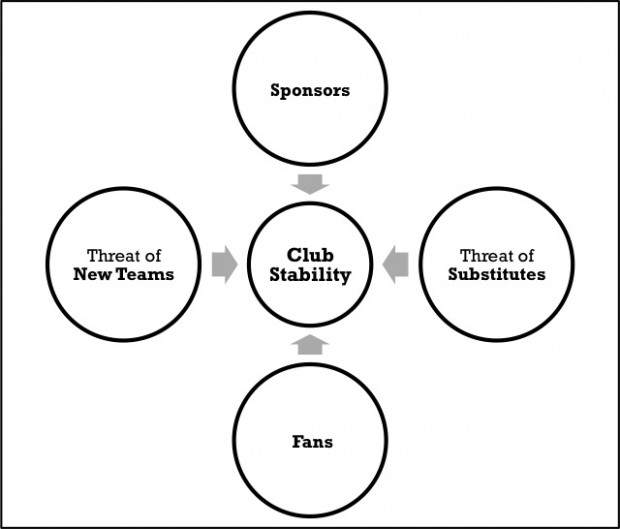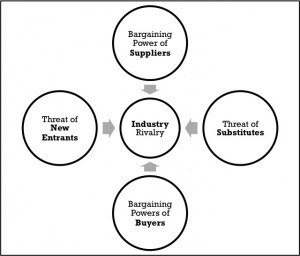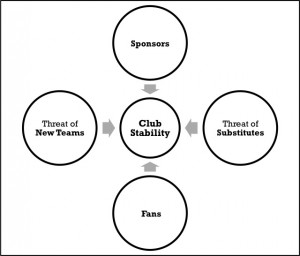
For decades, economic analysis models have been facilitators for business managers in establishing strategies on short-term and long-term scales. These analysis models are often quick to learn and easy to understand, but offer a wide range of applicable possibilities. With a number of adjustments, these models are not only suitable in analyzing a company’s status quo, but can also be used to help improve a football team, both financially and on the field.
This series of articles will look at select models and apply them within the context of American football. Based on the findings, several implications will be made that can help to not only make a team better, but also the entire organization.
To start off this series, I have decided to concentrate on Porter’s five forces analysis. This model is used in order to determine the situation within a market and the various factors that influence this current status.
 To help connect the dots between this model’s application for economic value and how it can be adopted for American football, let’s briefly introduce each field:
To help connect the dots between this model’s application for economic value and how it can be adopted for American football, let’s briefly introduce each field:
Threat of New Entrances
This factor mainly concentrates on possible new competitors that may enter the market in the near future. It looks at entrance barriers that make it hard for businesses to establish their products or services within their respective markets. For example, cost advantages of established businesses operating on the market, an aggravated access to distribution channels, or a loyal customer base that is hesitant to shift brand loyalty.
Threat of Substitutes
Here, the focus is on business with a similar application area: product and services that are comparable to what the specific business has to offer. In an analysis, these goods are then compared with one other in regards to their product and technical characteristics, their appeal to specific target groups, as well as their price-performance ratio.
With this, managers can try to predict how these factors may change future market shares and turnover figures, in addition to speculating on whether any developments on these factors have an impact as well.
Bargaining Power of Suppliers
In addition to having a firm understanding of their customers, businesses also need a strong understanding of the suppliers from which they get their production material. The two most important points here are (1) the number of suppliers in the area (the more there are, the better for a business) and (2) whether there is a possibility to integrate these suppliers into the company itself in order to reduce costs and to increase power and efficiency.
Bargaining Power of Buyers
Obviously, knowing one’s customers and how they might influence the company and its market situation is a crucial factor in establishing a strategy that ensures good market positioning. For business-to-consumer companies, focusing on customers’ influence over product and price developments is the most important aspect in understanding the buyer’s possible bargaining power. In contrast, business-to-business companies have to look at possible clients who have the interest in and potential to integrate the business into their own production process, thus decreasing the company’s influence tremendously.
All the aforementioned factors influence the market situation and ultimately, the fifth field of analysis:
Industry Rivalry
Not only do businesses have to acknowledge the factors that can influence present market situations, they also need to understand the conditions within the market itself. This means that they have to acquire an overview of the number of competing businesses, their current status quos, and how these companies distinguish themselves from one another in terms of what they provide for their customers. Moreover, another factor that must be examined is the current state of market share and growth in order to develop a good strategy for new products so that they sell well from the very beginning of their respective product life cycles. Lastly, businesses need to be aware of any exit barriers when planning to withdraw old products from the current market.
With this knowledge in mind, we can now apply this model to the context of American football. Whereas the traditional model looks at an entire market with several competitors, this article will concentrate exclusively on one organization. First, let’s look at what factors need to be transformed in order to use this model to analyze the financial and organizational structure of an American football club.
To maintain the structure established above, we will first look at the threat of new entrances into the American football market. In the case of a football organization, that means investigating whether there have been any efforts to establish a new club in the local area. If so, do they pose a threat to you, either competitively or financially?
 If a potential competitor is currently developing but has not yet been officially founded, one possibility might be to offer the opposition the opportunity to join your club. This gives them the opportunity to work with an already established and functioning team while you consolidate new knowledge, ideas, and potential sponsors from their involvement. One football team that is well-organized and has great appeal to sponsors and fans is far better than two rival teams that both struggle to obtain a fan base and support. If the opposing team does not come directly from your city, there is also the chance that they can try to reach a possible new pool of players previously unreachable for you until now.
If a potential competitor is currently developing but has not yet been officially founded, one possibility might be to offer the opposition the opportunity to join your club. This gives them the opportunity to work with an already established and functioning team while you consolidate new knowledge, ideas, and potential sponsors from their involvement. One football team that is well-organized and has great appeal to sponsors and fans is far better than two rival teams that both struggle to obtain a fan base and support. If the opposing team does not come directly from your city, there is also the chance that they can try to reach a possible new pool of players previously unreachable for you until now.
If the offer is refused or the new team has already been founded, then it is important to maintain the essential structures of your organization. That means making sure your fan base is at least stable, securing your current roster, developing a solid youth program, obtaining motivated and skilled personnel to handle all off-field activities, and strengthening your relationship with sponsors.
Aside from the threat of other American football teams in your local market, there is always the threat of alternative entertainment options – regardless of whether they’re connected to sports or not – to steal fans and sponsors from you. Here, you must keep an eye on the threat of other entities cutting into your market share.
After you’ve located potential rivals, consider what sets your sport and game day experience apart and consider how you can use those things to market your team. The strength of American football is that it is different from any other sport. This gives you a great opportunity to create publicity that appeals to potential fans and distinguishes yourself from your competition.
If you want to increase your audience, make sure to check which communication channel is most suitable for attracting new fans. You can achieve that by surveying your current fans or looking at statistics that can give you insight on how your fans first came in contact with your team.
For a niche sports organization, it is essential to have financial stability. In an American football context, sponsors can be viewed as suppliers who help ensure the financial stability of an organization so that it can function properly and compete at a high level on the field.
The two most important tasks here are to acquire new sponsors and to retain existing ones. For the former, you must have an appealing marketing concept that businesses can look at to see what you have to offer at first glance, plus you must indicate the costs and the value for the potential partner. The easiest way to find potential sponsors is to start with players and personnel within your organization. If there is already an personal connection between the company and the team via a third party, it might be easier to reach an agreement.
Another good way to find sponsors is to contact online enterprises, as they are not restricted by location. Through cooperation with your team they might obtain clientele that they may not otherwise reach.
If you want a sponsor to see you not only as a marketing channel but also as an entity that it is proud to support, you must ensure that the sponsor is both financially and personally connected to your football team. This can be accomplished by utilizing various methods simultaneously. Firstly, help the sponsor connect with the team. Visiting the sponsor, taking photos together, presenting them with a signed and framed jersey, giving the sponsor’s employees season tickets, and doing charitable work together are just a few examples. If the sponsor operates a company that offers products or services that your players can use, encourage the players to do so in order to show that your whole organization appreciates the sponsor’s contribution to the team.
In addition, it is important to show partners the results of their respective sponsorships and the value they gain from supporting you. Present the sponsor with statistics and photos demonstrating how the marketing campaign is being implemented and that your value as a platform for sponsors is increasing.
If you look at a football team as a service that provides entertainment to its customers, then the fans are the buyers that make use of this product. As it is with any other market, it is important to gain and retain market share. Aside from the aforementioned marketing campaigns, it is necessary to keep your fans engaged. You can do this by constantly updating your social media platforms, offering fans various merchandise options with occasional special offers, or by implementing sweepstakes for tickets, just to name a few options.
Another thing that creates a personal bond between your team and its fans is the establishment a booster club. With a booster club, participating fans are rewarded for their commitment to the organization with perks that they otherwise would not have access to, giving them the opportunity to belong to something that they’re passionate about while the team expresses its appreciation to them.
The people behind the scenes are always the basis for a team’s success. In order to function efficiently, you must have motivated personnel that are eager to help the organization succeed. There should be as many people working for your team as possible with varying skill levels. Do your best to avoid situations where only a few people are left to do all the work, and find ways to delegate responsibilities to ensure that your personnel feels engaged and motivated.
If you cannot find people willing to support the team, ask about potential volunteers among your team. Although it is not ideal to have a player simultaneously involved in team management, they are still an asset and can provide an immense help, so long as the work does not interfere with their level of play on the field.
Even if the players are not motivated to help out or can’t commit the time, they may know colleagues or friends willing to accept a position within the organization. Therefore, make sure to always make your vacancies public, thus increasing the probability of finding the perfect fit.
Aside from identifying who will take on which role, you must establish a functioning structure within the organization. This means determining precisely what each position’s tasks and decision-making authorities are. This avoids any possible conflict of interest and ensures that there is not an overlap in responsibilities, which can create inefficiencies. With a structure in place, everybody within the organization knows who is responsible for a given task and who to contact when certain problems arise.
While establishing this structure, make sure to create positions which do not interfere with one another, but rather build on one another’s work by having a constant exchange of ideas as well as collaborating on various projects.
This is part one of a series on how to apply economic analysis models to a football team. In part two, we will look at how this model can help to not only make your club better as an organization, but also how it can be used to improve the success of your team on the field. To read part two, click here.
Leon Häfner is a junior contributor and German editor who resides in Bayreuth, Germany. He began playing football for the Aschaffenburg Stallions at the age of 13 and currently plays wide receiver for the Hof Jokers. Leon is currently studying Business Administration at the University of Bayreuth. You can reach him via his Twitter handle at (@86haef).








